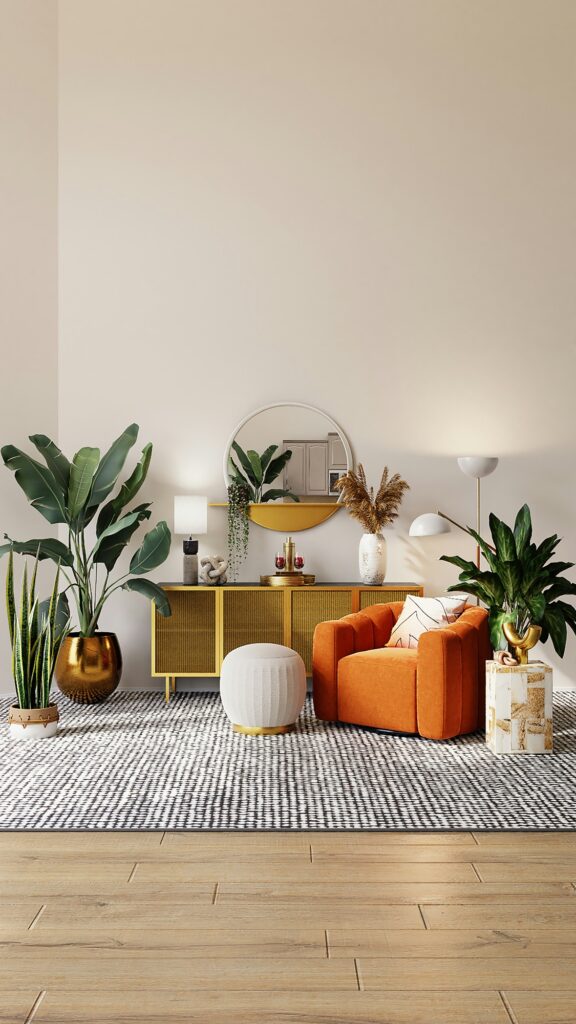
Have you ever sat down to focus on a big goal—writing, planning, resting—only to find yourself distracted by a pile of laundry, a cluttered counter, or a noisy space that just won’t cooperate?
You’re not alone.
In fact, your home might be working against you more than you realize. And no, it’s not personal—it’s design.
Our previous post on functional spaces struck a nerve, and it’s no surprise why: how you live inside your space deeply impacts how you show up for your life. This post takes things a step further. Because creating a supportive home design isn’t just about decluttering or organizing—it’s about strategically shaping your space to serve your goals.
Whether your aim is to write your book, stick to a workout routine, build a business, or simply have more peace in your day, the space around you is either helping—or subtly sabotaging.
Let’s talk about how to design a home that cheers you on.

1. Clutter Isn’t Just Visual—It’s Mental and Emotional, Too
Clutter is more than mess. It’s unmade decisions. It’s postponed action. It’s emotional noise.
Studies show that visual clutter increases cortisol, reduces focus, and triggers stress—especially in women and moms, who are often already carrying a high mental load. That pile of papers on the counter? Your brain registers it as “unfinished business,” draining energy you could be using to actually pursue your goals.
Decluttering for mental clarity isn’t just a minimalist fantasy. It’s a strategic move for your peace and productivity.
📝 Try this: Walk through one high-traffic area of your home and ask: What here is unfinished, out of place, or outdated? Clear just that one zone—and notice how different your energy feels.
2. Your Home Should Reflect Your Goals—Not Just Your Stuff
If you walked into your own home without context, would you know what matters most to the person who lives there?
Your space should reflect what you’re moving toward—not just what you’ve accumulated.
Want to build a writing habit? Make space for it—literally. Even a small corner with a notebook and a candle can serve as a sacred cue. Trying to eat better? Clear pantry clutter and place nutritious snacks at eye level. Need more movement? Leave your yoga mat rolled out instead of hidden in a closet.
Your home is like a vision board you live inside. If your goals aren’t visible, they’re not being supported.
🔎 Ask yourself: What’s one small area I can shift today to better reflect who I’m becoming?
3. Define Function by Season (Not Perfection)
Perfection isn’t the point. Function is.
And more than that—seasonal function is key.
What serves you right now in this season of life? A perfectly styled minimalist living room might look beautiful on Pinterest, but if you’ve got toddlers, that setup might actually sabotage your sanity.
Function means:
-A basket of toys in the living room so you can breathe while you cook
-A folding table that doubles as a workspace because your dreams can’t wait for a bigger house
-Storage bins that aren’t pretty, but they work
This isn’t forever. It’s for now. And that makes it valuable.
🌱 Permission slip: Your home doesn’t have to be perfect—it just needs to serve you well in the life you’re actually living.
4. Micro-Zones: Make Your Home Work With You, Not Against You
One of the easiest ways to create a functional home—without a full renovation—is by introducing micro-zones: small, purposeful areas that help you complete specific tasks more smoothly.
Micro-zones aren’t just for fancy interior design spreads. They’re for real moms, in real homes, with real goals. They help reduce friction, decision fatigue, and chaos.
Here are some micro-zone ideas that support your life goals:
-A drop zone by the door: Hooks, baskets, or a small bench that says, “We know where our keys, bags, and mail go.”
-A morning prep station: A countertop tray with vitamins, breakfast essentials, and lunch supplies = smoother school-day launches.
-A command center: A wall calendar, whiteboard, or digital screen showing your schedule, goals, or affirmations to keep you centered.
-A mindset corner: A chair, a journal, and five minutes a day. That’s all it takes to start creating change.
🎯 Think of micro-zones as “goal anchors”—tiny spots in your home that remind you who you are and what you’re building.
5. Energy Flows Where Attention Goes: The Psychology of Placement
Your environment is constantly shaping your behavior, even when you don’t realize it.
The items you see first thing in the morning? They nudge your attention. The layout of your kitchen? It influences what and how you eat. The visibility of your planner, journal, or laptop? It directly impacts how often you use them.
Sometimes we think we’re a disorganized mess. But the truth is, you’re not disorganized. Your home is just prompting the wrong habits.
✨ Some small but powerful placement shifts:
-Put your journal and pen on your nightstand, not tucked in a drawer.
-Keep a water bottle filled and on your desk. Display your goals or intentions on your fridge, mirror, or wall.
-Place your dumbbells by the TV so movement becomes part of your downtime.
Your habits don’t just live in your head—they live in your space.
6. Design for Rest and Restoration, Too
We talk a lot about designing for productivity—but designing for rest is just as vital. Especially for moms.
Your nervous system needs beauty, softness, and places to land. Rest is not a reward. It’s a requirement.
Make sure your home includes:
-A soft, no-judgment zone (a cozy chair with a blanket and a book)
-Calming elements like soft lighting, plants, candles, or art that brings you joy
-Clear cues that it’s okay to rest: unlit devices, visible books, warm textures
If your space only tells you to do more, you’ll burn out.
Let your home tell you: You deserve to exhale, too.
💡 Remember: Rest is part of the work. A well-rested woman is unstoppable.
7. Quick Home Audit: Is Your Space Supporting or Sabotaging?
Before you overhaul your whole house, let’s simplify. Here’s a quick audit to help you assess where to make your first shift:
📝 Home Audit Questions:
-Do your goals have a visible presence in your space?
-Are there daily friction points (like missing keys, messy counters, or noisy corners)?
-Is there one area of your home that energizes you? What makes it work?
-Where in your home do you feel stuck, overwhelmed, or distracted?
-What’s one small shift you could make today to support your current season?
Don’t aim for a Pinterest-perfect space. Aim for a purposeful one.
🛋️ Your Home Is More Than a Container—It’s a Co-Creator
You don’t need a bigger house. Or a professional organizer. Or a weekend to gut the garage.
You need a mindset shift: Your home should support the life you want—not the stress you don’t.
This is how you create a home that supports your goals:
-Intentionally
-Gradually
-With honesty about your current season
-And with love for the woman who lives there
💡 Ready to Take It Further?

If this post spoke to you, you’ll love my book Mom Take Center Stage. It’s part personal story, part empowerment guide—and all about designing a life (and home) that reflects your purpose, values, and worth.
👉 Grab your copy (Amazon preorder link or find the book anywhere you purchase books)
👉 Join the newsletter for weekly insights and tools
👉 Share this post with a fellow mom who deserves a supportive space
Your space matters. So do you.
Let’s make sure your home knows that.
💬 I’d love to hear from you:
What’s one small change you’ve made to your home that had a big impact on your focus, peace, or productivity? Or—what area of your home feels most out of sync with your goals right now?
Drop it in the comments—I read every one and love hearing how you’re creating spaces that support the woman you’re becoming. 💛
Photo credits: https://unsplash.com/@spacejoy






